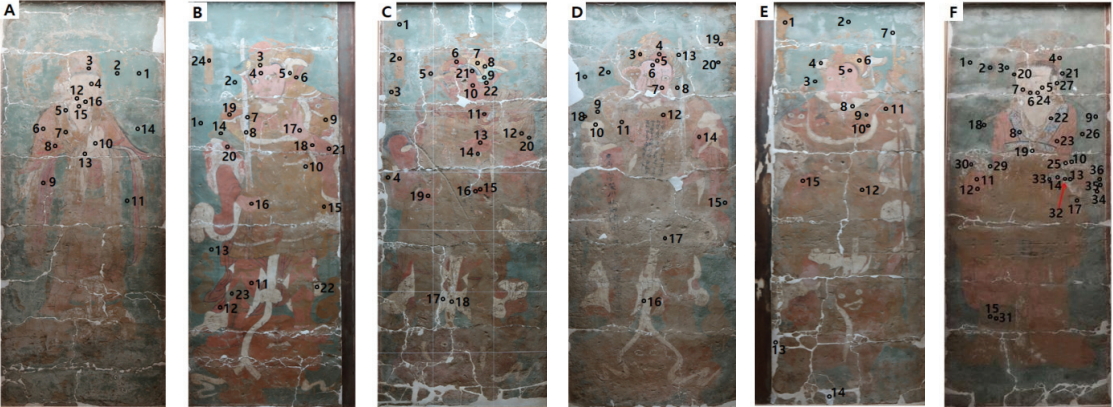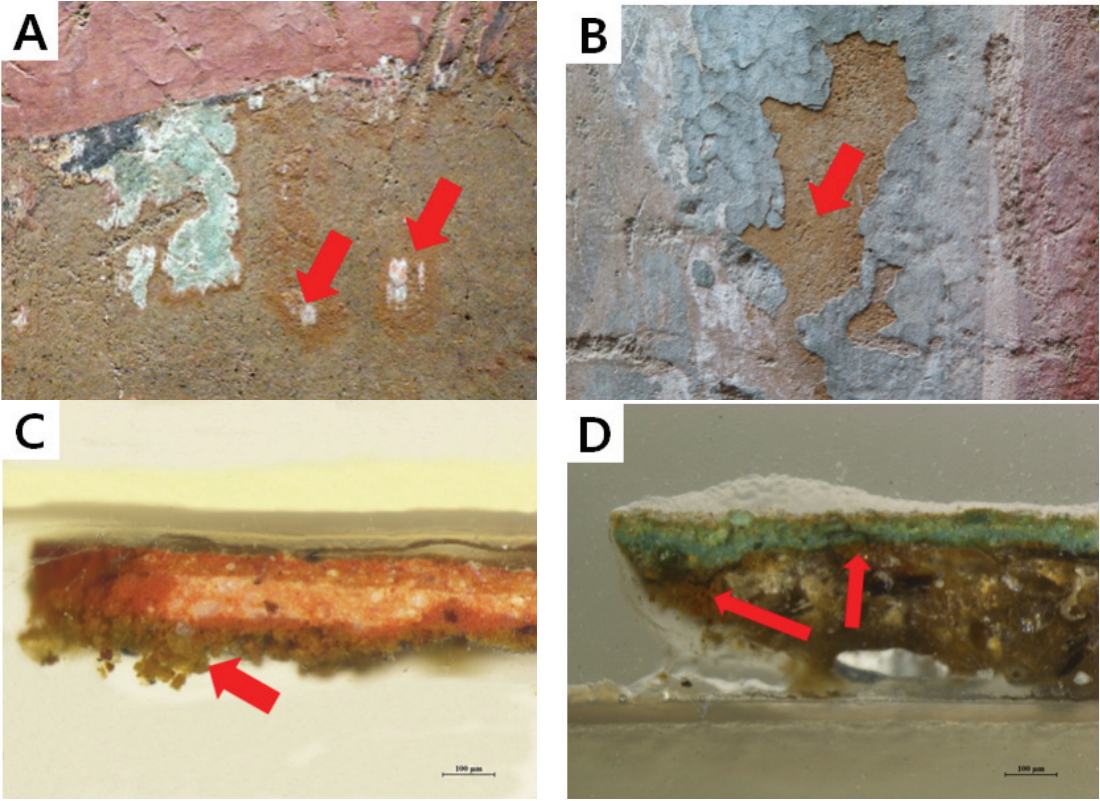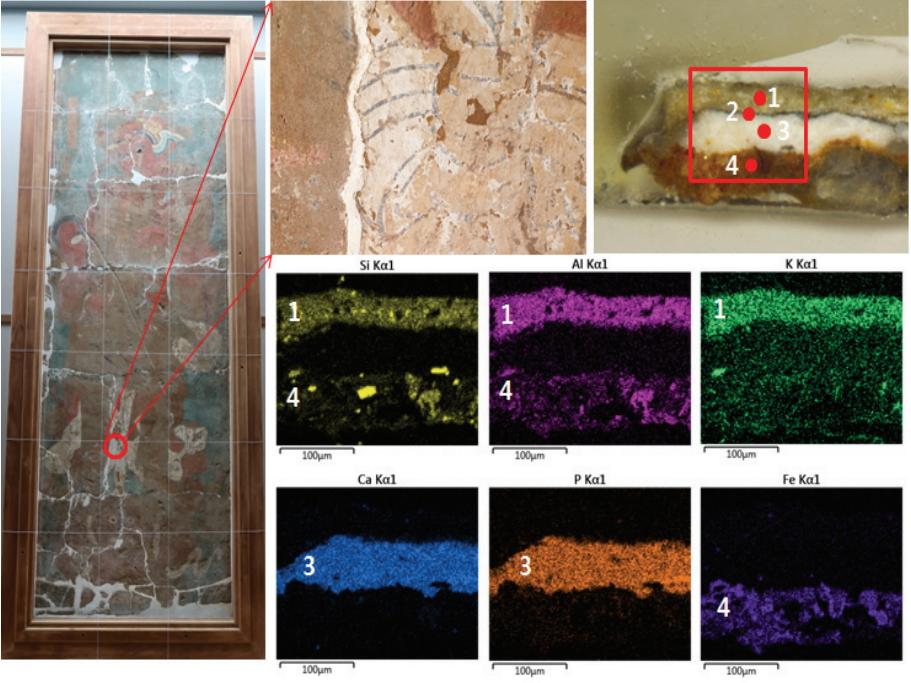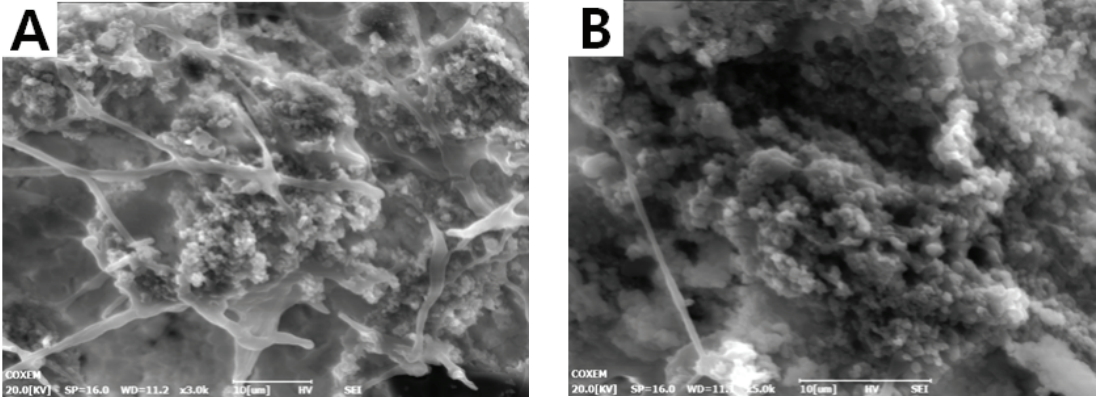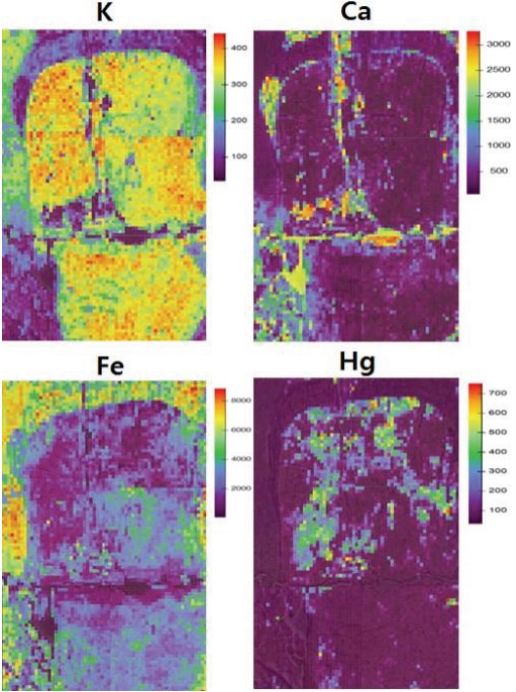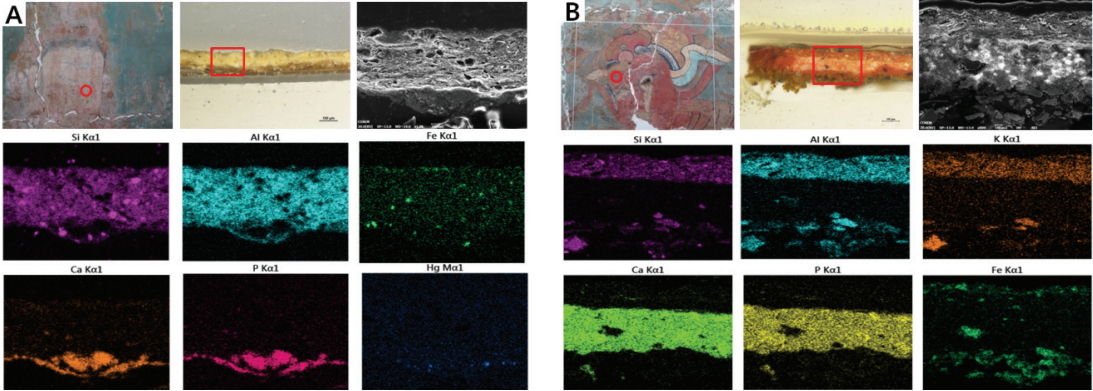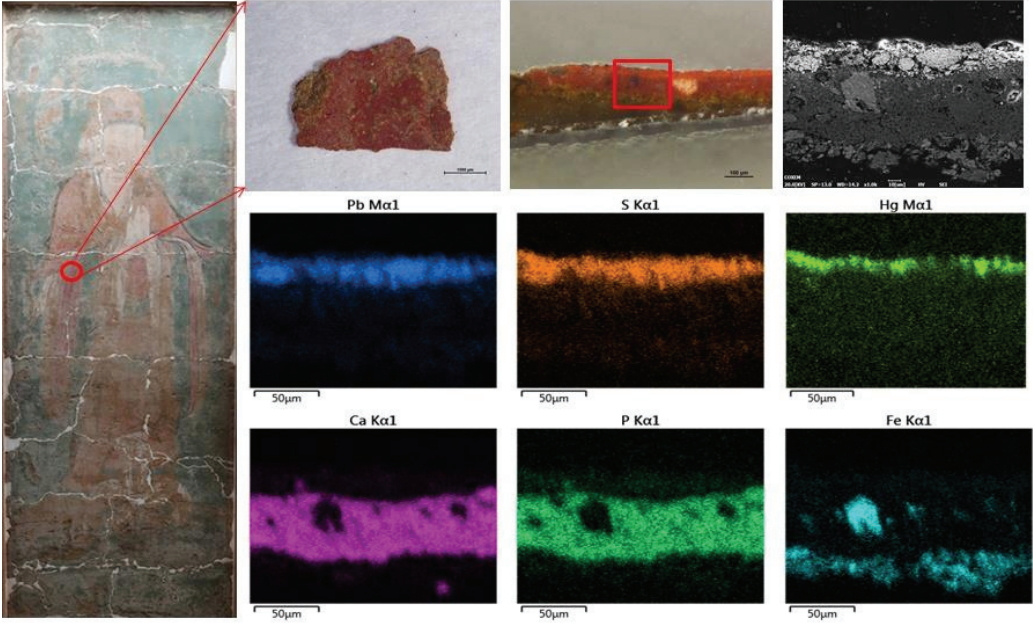1. INTRODUCTION
The Josadang murals(National treasure No. 46) stored at the Sungbo Museum of Buseoksa in Yeongju, Gyeongsangbuk- do, South Korea are the only murals from the Goryeo period in existence today. Most of the existing Buddhist temple murals in Korea were painted after the mid-Joseon period, while the Josadang murals at Buseoksa, Yeongju, Daeungjeon murals at Sudeoksa, Yesan, Daeungjeon murals at Bongjeongsa, Andong, and Geungnakjeon murals at Muwisa, Gangjin are known to have been painted prior to mid-Joseon period. Of these, the Josadang murals at Buseoksa are the earliest and the only ones painted during the Goryeo period(3rd year of the reign of King U, 1377) and are, therefore, particularly significant for the study Korean Buddhist temple murals.
Previous studies of the pigments in Korea were conducted primarily for the paintings created after the 17th century, in the mid-Joseon period. When many cultural artifacts were damaged during the Japanese and the Second Manchu invasions of Joseon, both movable cultural properties, such as Buddhist paintings and portraits, and immovable properties, such as dancheong(traditional Korean decorative coloring on wooden buildings) and Buddhist temple murals, were lost to fire. They were painted again when Buddhist temples were rebuilt or repaired across the country.
Scientific studies published on Buddhist temple murals in Korea include X-ray diffraction analysis of Kumsansa mural Painting and Danchong(Hong and Chung, 1992), the analysis study of mural painting pigments at Pongjongsa Kuknakjon(II)(Cho et al., 2000), comparative study on the pigments applied on the wall paintings of temple in 18-19C(Son et al., 2013), pigment analysis and nondestructive deterioration diagnosis of the wall paintings in Gwanyongsayaksajeon(Yaksajeon Hall of Gwanyongsa Temple), Changnyeong, Korea(Chun et al., 2009), and pigment analysis for wall paintings according to verification of penetration depth for X-ray: Ssanggyesa Daeungjeon(main hall of Ssanggyesa temple) in Nonsan(Chun et al., 2011). Several ongoing projects are being carried out to preserve and document Buddhist temple murals and research is being conducted continuously for the Geungnakjeon Amitabha Buddha triad mural and the white-robed Avalokitesvara painting at Muwisa, Gangjin, Geungnakjeon murals at Daewonsa, Boseong, the Buddhist scroll painting at Magoksa, Gongju, and the Geungnakjeon Buddhist mural at Wibongsa, Wanju. However, most Buddhist temple murals were painted in the late Joseon period after the Japanese invasions and only limited records are available regarding the materials used in the murals that were painted prior to the late Joseon period. Hence, findings about the paint pigments in the Josadang murals will provide important evidence for examining the use of pigments from the late Goryeo period to the early Joseon period.
The Josadang murals were first treated for preservation by Japan during the 1920s, and this was followed by short-term form of the treatments in 1984 and 2002. However, a precise scientific analysis of these murals was first conducted only in 2018 and focused on preservation conditions of murals, structural safety diagnosis, and paint pigments along with the materials of wall(Buseoksa et al., 2018). The present study is a continuation of this research and aims to analyze the paint pigments and to identify the types of pigments used in the murals.
2. EXPERIMENT
2.1. Objects
The Buseoksa Josadang murals consist of six paintings on each wall: East Virūḍhaka, West Virūḍhaka, South Virūḍhaka, North Virūḍhaka, Śakra, and Brahmā(Figure 1). Each mural has dimensions of 72–81 cm × 209–212 cm and was originally painted in the inner wall. Subsequently, the murals were removed from the walls and placed on a wooden frame during the preservation in the 1920s and have been kept in this state to date.
In all six murals, traces of inscriptions are still present at the top of each mural, and small cracks in random directions, along with six large cracks at consistent intervals in the horizontal direction, have formed. The cracks and some parts of the walls that fell off were replaced with white pigment as repair materials. The remaining parts of the murals were in poor condition with a substantial portion of the paint layer chipped off and the bottom background layer exposed. In this work, optical microscopy, X-ray fluorescence(XRF) spectroscopy, and XRF mapping were used to analyze the paint pigments in the murals. To observe the paint layers of the murals and identify their pigment materials, samples were collected for each color and analyzed using scanning electron microscopy–energy dispersive X-ray spectroscopy(SEM-EDS) and Raman spectroscopy.
2.2. Optical microscopy
For optical microscopy, a hand-held digital microscope (Digital Microscope, Scalar Corp. DG-3, Japan) was used to observe the particle size and mixture of the pigments at the magnifications of × 30, × 100, and × 200. Here, × 30 magnification was used to determine the murals’ painting technique and overlap with surrounding colors, while × 100 and × 200 magnifications were used to analyze the presence of the particles in the pigments, the particle shape, and the mixture of the pigments.
2.3. X-ray fluorescence spectroscopy
A portable X-ray fluorescence spectrometer(Titan Tracer 5i, Bruker, DEU and Vanta, Olympus, JPN) was used to analyze the elements in the pigments. The analysis was conducted on the relatively clean areas of the murals. The spectroscopy measurements were carried out for a total of 30- 60 s using the 40 kV X-ray tube and another 30 s at 15 kV. In addition, an area of 1 cm2 was measured in the atmospheric environment. For the measured spectrum, the elements detected with high intensities in each color were compared against the background and were considered to have contributed to the measured color; these results were then used to tentatively identify the pigments that were used in the murals. XRF mapping for the paint layers in the murals was performed using a portable micro X-ray fluorescence spectrometer mounted with mapping equipment. The XRF mapping equipment(ELIO, Bruker, DEU) was used as the spectrometer, with a 40 kV X-ray tube in the ambient air, and a 10 × 10 cm2 area was mapped at 3 mm intervals every second.
2.4. SEM-EDS
To observe the particles in the pigments, a small region of the collected samples was magnified and observed using a stereomicroscope(SMZ18, Nikon, JPN), and then, based on the obtained results, scanning electron microscopy (SEM)(EM-30AX Plus, Coxem, KOR) and energy-dispersive X-ray spectroscopy(EDS)(Aztec one, Oxford, GBR) were used for elemental analysis. The EDS measurements were carried out at 20 kV, WD of 15 mm, a spot size of 40, and a measurement time of 100 s.
2.5. Raman spectroscopy
Raman spectroscopy is a spectroscopic technique based on inelastic scattering of monochromatic light. Raman scattering refers to inelastic scattering due to energy loss or gain during the scattering when light passes through the medium. Raman spectroscopy can detect the Raman peaks specific to particular pigments at the particle level and identify the types of pigments. A Raman spectrometer(LabRAM ARAMIS, Horiba Scientific, JPN) was used in this study, and a 632.8 nm (HeNe) laser with a × 500 lens was used for the measurements.
3. RESULTS AND DISCUSSION
3.1. Painting technique
The Buseoksa Josadang murals were based on a yellow primer layer painted across the entire area, and the figures were painted directly on top of the background without a covered layer(Figures 2A and 2B). In the Joseon murals, the covered layer was usually painted across the entire area. The painting was carried out in the following order; the finish layer, primer layer, covered layer, and paint layer, followed by celadonite(a greyish green pigment) that was used to cover the entire area, and then the main paintings were painted again on top of celadonite. This painting technique is characteristic of many Joseon murals, such as the Geungnakjeon murals at Silleuksa, Jecheon, Daeungjeon murals at Jikjisa, Gimcheon, Youngsanjeon murals at Tongdosa, Yangsan(Han et al., 2011) and Geungnakjeon murals at Hwaamsa, Wanju(Wanju-gun and Sungbo Preservation Institute, 2018). However, in the Buseoksa Josadang murals, greyish green pigments were only used for the background, and thus, the murals are considered to have been created by a painting technique different from that used in the Joseon period.
In Jasadang murals, two paint layers were found(Figures 2C and 2D). The second paint layer was painted directly on top of the first layer without any background and covered painting. It is presumed that repainting was carried out directly on top of the painting without any finish that otherwise would have removed the previous paint layer or the background painting.
3.2. Pigments
3.2.1. Background
In the background area, Fe was detected as the main element with trace amounts of Si, K, Ca, Ti, Rb, Sr, and Zr; this appears to suggest that the background consisted of soil materials such as yellow ochre(Table 1, Figure 3A). Depending on the area, trace amounts of Cu, Hg, and Pb were also detected that appeared to be due to the pigments that remained after the paint layer fell off in that area.
3.2.2. Greyish green
Greyish green pigments showed a mixture of particles with varying colors from dark green to light green and the microscopic characteristics of typical celadonite. An XRF analysis of the greyish green area detected Fe as the primary element along with trace amounts of K and Ca(Table 1, Figure 3B). Two painting layers were observed in the greyish-green area in the Josadang murals. An SEM-EDS analysis on each of the layers detected Fe as the main element in both layers together with traces of K, Al, Si, and Mg. Given these results, the greyish-green pigments in the Josadang murals are presumed to have used celadonite (K(Mg,Fe2+)(Fe3+,Al)[Si4O10](OH2)) in both layers. However, a comparison of the particle size in the bottom and the top paint layers confirmed that pigment particles in the bottom layer were relatively larger and more uneven, clearly distinguishing these two layers(Figure 4).
3.2.3. White
An XRF analysis of the white area detected Fe, Ca, K, Al, Si, P, and S with trace amounts of Au in some parts(Table 1, Figure 3C). Light elements such as Al, Si, K, and Ca are the typical constituents of white clay, and the white pigments present in the Josadang murals were presumed to originate from white clay. However, the intensities of Ca and P detected in the white area in the Josadang murals were found to be higher than those of typical white clay, and the intensities of the two elements were higher in the area where the bottom layer was exposed. These characteristics were found in for all six murals. The cross-section of the white pigment sample collected from BSJ-M-3 was analyzed(Figure 5), finding four layers of white/black/white/yellow colors from top to bottom. Since there was a black layer between the white layers, it was presumed that the white area was painted at another point in time, and not consecutively at the same time period. An EDS analysis of each layer detected Si, Al, and K as the main elements in the top white layer and Ca and P as the main elements in the bottom white layer, confirming that the two white layers came from different materials. In the area where Ca and P were detected, the pigment particles were nanoscale and very small(Figure 6). These characteristics are observed when the materials are fired. Comparison to the data obtained in the previous studies showed that the Raman spectroscopy confirmed that this spectrum was similar to that of the artificially produced [Ca2(PO4)2], bones containing collagen, and materials taken from burned animal bones(Figure 7) (Bordes et al., 2017;Marques et al., 2018;Jillavenkatesa and Condrate Sr, 1998).
Natural white materials with Ca and P as the main elements, include fluorapatite[Ca5(PO4)3F2], which is a major component of teeth and bones. Fluorapatite mostly comes from Canada, Mexico, Brazil, Russia, Japan, and Myanmar, and is not produced in Korea(Doopedia, 2020). Fluorapatite is artificially obtained by firing animal bones, and the primary component of the material obtained using this method is [Ca2(PO4)2]. White pigments that consist of this component are called bone white and were used in paintings with the paper or parchment background in medieval Europe(Gettens and Stout, 1996). Typical bone white is known to be a greyish white or a somewhat sandy powder. White pigments used in the Josadang murals are pure with very high Ca and P contents and almost no light elements that are usually detected in minerals. Considering these results, it is highly likely that the white pigments in the Buseoksa Josadang murals have originated from the white powder obtained by burning animal bones. The white pigments that have been traditionally used in Korea include white clay, soil pigment, white lead, and a Pb pigment. Until the early Joseon period, white clay rather than white lead was often used as a white pigment for murals or dancheong. The use of white lead increased towards the late Joseon period; however, white clay was also used consistently for mural backgrounds. By contrast, the use of white pigments containing Ca as the main element has not been identified for painting materials and was confirmed for the first time in the Josadang murals. For murals or paintings from the same period in Japan and China, kirakumen No. 115 garuda(Treasure) in Shōsōin, it was confirmed that apatite [Ca5(PO4)3(OH,Cl,F)] was used in Japan(Kimura and Naruse, 1988), but is not found in China.
3.2.4. Skin color
The faces of the figures in the Śakra(BSJ-M-1) and Brahmā(BSJ-M-6) murals used pale pink skin colors and the Virūḍhaka(BSJ-M-2 to 5) murals used bright pink. For the six murals, Fe, Ca, and K were detected as the main elements along with light elements such as Ti, Mn, Rb, Sr, Zr, Al, Si, and P(Table 1, Figures 3D and 3E). These elements are usually found in the soil; thus, soil pigments appear to have been used in the skin colors of the six murals. However, a comparison of the elemental contents detected in the skin colors of these murals showed that the largest difference was observed for the Fe content. BSJ-M-2-5, featuring Virūḍhaka, showed stronger intensities of Fe than BSJ-M-1 and BSJ-M-6, featuring Śakra and Brahmā. Furthermore, trace amounts of mercury(Hg) were also detected in the Śakra and Brahmā murals unlike for the Virūḍhaka murals. The XRF mapping image of the Brahmā’s face showed that mercury(Hg) was distributed in certain areas of the face(Figure 8). In the Brahmā mural, mercury(Hg) was found distributed in a part of the entire area rather than across the entire area.
The cross-sections of the samples collected from the faces of BSJ-M-1 and BSJ-M-3 confirmed the presence of two paint layers in both murals(Figure 9). Meanwhile, Si, Al, and Fe were mixed at the top layer of BSJ-M-1, with a low proportion of Fe. At its bottom layer, Ca and P were mixed with trace amounts of Hg. XRF mapping also showed a low content of Hg, partially in the face. For the pigments in BSJ-M-3, three paint layers were observed: Fe was the main element at the top layer, Si and Al were concentrated at the 2nd layer, and Ca and P at the 3rd layer. To summarize, different pigments were used in the top and bottom paint layers of these murals. Calcium phosphate white pigment(Ca, P) + cinnabar(HgS) changed to white clay + red ocher in BSJ-M-1, whereas calcium phosphate white pigment(Ca, P) + red ocher changed to red ocher in BSJ-M-3.
3.2.5. Reddish orange
From visual observation, it was observed that reddish-orange color was mostly painted on top of orange pigments. An XRF analysis showed Hg and Pb as the main elements; Fe, Ca, Si, P, K, and Ti were detected together, depending on the area(Table 1, Figure 3F). An observation of the cross-section in this area confirmed four paint layers(Figure 10). From top to bottom, the 1st and 2nd layers consisted of reddish-orange(Hg) and orange(Pb) while the 3rd layer was reddish-brown with a mixture of Ca, P, and Fe. In the 4th background layer, Fe was detected as the main element. Hence, it is presumed that the 3rd layer was the original paint layer mixed with white pigments containing Ca and P and red pigments containing Fe, while the 1st and 2nd layers were the repainting layers for which minium(Pb3O4) and cinnabar or vermilion were used.
3.2.6. Gold
Gold was used on top of the red paint layer only, and given the ruggedness or cutoffs of the surface, it is possible that gold foils were used. In the gold area of all the murals, Au was commonly detected as the main element along with Fe, Ca, and P. Hg and Pb were also detected together, depending on the area(Table 1, Figure 3G). Given that impurities such as Ag and Ni were not detected with the gold, it is presumed that gold leaves were used. Analysis of the intensities of the elements detected in the gold area shows that higher intensities were observed for Ca, Fe, and P. Microscopy also revealed a yellow background layer in the gold foil background, a pink layer, which is presumed to be the original paint layer, and red pigments on top of the gold foils in some parts. Given these results, it is highly probable that gold foils were the painting materials used in the original painting.
3.2.7. Green
In the green area in the Josadang murals, it was observed that dark green pigment particles were in some cases placed on top of the light green layer, suggesting that two types of pigments were used. Furthermore, an observation of the green pigment paint layer showed that with the exception of except for BSJ-M-6, the murals were painted in the order of light green/greyish green/white or light green/greyish green/pink/ yellow. The greyish-green pigments were not used for covering the entire area but only as the background pigments for the green area in the Josadang murals. This suggests that the murals have a unique painting technique that has not been identified in Korea’s other dancheong and murals.
In most of the light green areas in the Josadang murals, Pb and Sn were detected together with Cu, which is the main element for green; in some parts, Zn was also detected(Table 1, Figure 3H). Almost no green pigments identified in traditional Korean dancheong or murals used malachite, which is a natural pigment. Rather, most of them used artificially created pigments based on copper(Song, 2018). Traditional copper alloys are composed of bronze and brass, containing Cu/Sn/Pb and Cu/Zn/Pb, as the main elements, respectively. As revealed in the usage trend in the Joseon period, bronze transitioned into brass after the mid- and late 17th century, probably because zinc was much cheaper than tin during this period(Jang et al., 2015). Coinciding with this transition, pigments containing Cu/Zn/Pb emerged in green pigments used in the Joseon period dancheong after the 17th century, but patina containing tin(Sn) was detected less frequently(Song, 2018). Hence, it is presumed that the green pigments in the Josadang murals were artificially produced, and the detection of Sn and Zn suggests that the top layer was repainted, sometime after the 17th century. Since Cu and Cl are detected in dark green lotus leaves, it is concluded that copper chloride green pigments such as paratacamite or botallackite could have been used.
3.2.8. Blue
An XRF analysis of the blue area detected Cu, Ca, and Fe as the primary elements with trace amounts of Ti and Mn(Table 1, Figure 3I). The blue pigments have particles with a size of 10-30 μm and were relatively larger. The pigments showed bluish glaze colors and cracked particles; thus, they are considered to have the characteristics of mineral particles(Figure 11). Hence, blue pigments came from azurite that has Cu as the main element. Since the blue pigment was painted on the white paint layer containing Ca and P or yellow primer layer, this layer is presumed to be the original paint layer.
4. CONCLUSION
1. Buseoksa Josadang murals consisted of one background layer and two paint layers, and they were repainted on the top of the existing paint layers without any surface polishing or new background layers. The layers were divided into the background layer for which greyish green pigments were used only for the background area, and the paint layer where the colors were painted. This differs from a typical Buddhist mural painting technique in the Joseon period where greyish green covered the entire area.
2. It was confirmed that different pigments were used for all of the colors in the two paint layers. It was estimated that celadonite, white clay, red ochre, cinnabar and minium, synthetic green pigment containing tin and zinc, paratacamite or botallackite were used in the upper layer. In addition, bone white, celadonite, red ochre, azurite, cinnabar or vermilion and gold foil were identified in the bottom layer.
3. Especially, white pigments containing Ca and P were used for painting the base layer with blue or mixed pigments such as skin color and red color in the bottom layer.
4. It is not possible to clearly distinguish the timing of the painting for all of the pigments of each color. However, tin and zinc were detected together in green pigments that are presumed to have been repainted, and they are important guiding elements that help to determine the repainting period. It is highly probable that the Josadang murals were repainted above the original paint layer after the 17th century. Furthermore, greyish green pigments were used to paint only the background in the green area, which is a unique painting technique that has not been used in conventional dancheong or murals.
5. Since the Korean artifacts where pigments from the Goryeo period can be identified are only limited to Goryeo Buddhist paintings, almost no information has been revealed about the pigments used during the Goryeo period. It is estimated that the Buseoksa Josadang murals were painted between the late Goryeo period and the early Joseon period, and the results from this analysis are expected to serve as an important reference for understanding the use of the pigments in the Goryeo period. Specifically, the use of calcium phosphate white pigments containing calcium and phosphorus in the Korean traditional paintings has been confirmed for the first time, which is highly significant for the study of painting materials.




